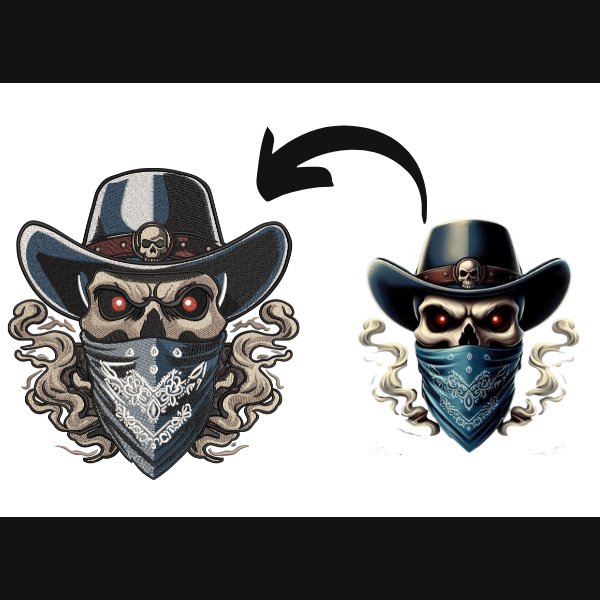Digitizing Logos for Embroidery on Difficult Fabrics: Leather, Denim, and More

Strong 8k brings an ultra-HD IPTV experience to your living room and your pocket.
Embroidery on challenging fabrics like leather, denim, and other thick or delicate materials requires precision, expertise, and the right tools. Achieving flawless embroidery designs begins with accurately digitizing a logo for embroidery, a process that involves converting a logo into a format compatible with embroidery machines. When working with difficult fabrics, the process becomes even more critical to ensure durability, clarity, and visual appeal.
In this blog, we’ll explore the nuances of logo digitization for challenging fabrics, provide actionable tips, and highlight the importance of using an image digitizer for embroidery to optimize results.
The Challenge of Embroidering on Difficult Fabrics
Certain fabrics pose unique challenges due to their texture, thickness, or flexibility. For instance:
- Leather
- Dense and non-porous, leather requires minimal perforation to avoid damage.
- Thread tension and stabilizer choice are crucial for clean results.
- Denim
- Thick yet prone to fraying, denim requires high-density stitches.
- Proper hooping is essential to prevent distortion.
- Stretch Fabrics (e.g., Lycra, Spandex)
- Stretchy fabrics can lead to puckering or misaligned stitches without proper stabilization.
- Silk and Satin
- Delicate and smooth, these fabrics are easily damaged by incorrect stitch density.
- Velvet and Corduroy
- Raised textures can cause stitches to sink, reducing visibility.
Each of these materials demands customized digitization techniques to achieve high-quality embroidery.
Why Digitization Matters for Difficult Fabrics
The process to digitize logo for embroidery is critical when working with challenging materials because it:
- Controls Stitch Placement: Ensures the embroidery machine knows exactly how to stitch the design without damaging the fabric.
- Optimizes Stitch Density: Adjusts the number of stitches per inch to suit fabric thickness and texture.
- Prevents Fabric Damage: Minimizes perforation risks by tailoring the design to fabric properties.
- Maintains Design Integrity: Keeps logos visually consistent across various materials.
Key Steps to Digitize Logos for Embroidery on Difficult Fabrics
1. Choose the Right Software
Invest in a high-quality image digitizer for embroidery, such as Wilcom, Hatch, or Brother PE-Design. These tools allow you to adjust stitch density, tension, and design elements for specific fabrics.
2. Simplify the Logo Design
Complex designs with intricate details may not translate well on textured or thick materials. Simplify the design while retaining its core identity.
3. Adjust Stitch Density
- Leather: Use low-density stitches to prevent perforation.
- Denim: Opt for higher-density stitches to accommodate the fabric's thickness.
- Delicate Fabrics: Use lightweight stitches to avoid puckering.
4. Use Appropriate Underlay Stitches
Underlay stitches create a foundation for the main embroidery, stabilizing the fabric and enhancing stitch clarity. Common underlay techniques include:
- Edge Walk: For stabilizing edges.
- Zigzag: For creating a cushion layer on thick fabrics.
- Fill Underlay: For dense designs on smooth fabrics.
5. Match Thread and Needle Types
Choose threads and needles that complement the fabric type:
- Leather: Use bonded polyester or nylon threads and leather-point needles.
- Denim: Heavy-duty threads with sharp-point needles.
- Silk/Satin: Fine threads and ballpoint needles to prevent fabric tearing.
6. Stabilize the Fabric Properly
- Cut-Away Stabilizers: Ideal for thick fabrics like denim and leather.
- Tear-Away Stabilizers: Suitable for less dense materials.
- Water-Soluble Stabilizers: Best for delicate fabrics or raised textures like velvet.
Best Practices for Embroidery on Difficult Fabrics
1. Test Before Production
Always run a test embroidery to ensure the design is optimized for the specific fabric. This step helps identify and fix potential issues.
2. Use Proper Hooping Techniques
Hooping prevents fabric movement during stitching, ensuring precise embroidery. For non-hoop-friendly fabrics like leather, use adhesives or clamps.
3. Avoid Excessive Stretching
While hooping stretchable fabrics, avoid overstretching, as it may lead to design distortion.
4. Mind the Stitch Direction
Directional stitching minimizes distortion on textured fabrics and enhances design aesthetics.
How Embroidered Logos Boost Brand Appeal on Difficult Fabrics
Logos embroidered on materials like leather and denim exude a premium feel, making them ideal for high-end branding. Here’s how:
- Leather: Embroidered leather products like jackets and bags convey luxury and sophistication.
- Denim: Adds rugged, durable appeal to casual and corporate merchandise.
- Stretch and Delicate Fabrics: Perfect for niche markets like sportswear and fashion apparel.
By mastering digitization for these fabrics, businesses can tap into new markets and diversify their branding efforts.
Top Tools for Logo Digitization on Challenging Fabrics
- Wilcom: Advanced features for customizing designs to suit various materials.
- Hatch Embroidery: Offers intuitive tools for adjusting stitch types and densities.
- Embird: A versatile tool compatible with multiple embroidery file formats.
- Brother PE-Design: Optimized for Brother embroidery machines, ideal for hobbyists and professionals.
- Janome Digitizer MBX: A robust solution for digitizing logos for thick and textured fabrics.
Common Challenges and Solutions
1. Fabric Distortion
Problem: Fabric moves during stitching, causing misaligned designs.
Solution: Use strong stabilizers and proper hooping techniques.
2. Needle Breakage
Problem: Thick materials like leather can break needles.
Solution: Use leather-specific needles and reduce stitch density.
3. Stitch Sinking
Problem: Stitches disappear into raised fabrics like velvet.
Solution: Use water-soluble stabilizers to keep stitches visible.
4. Puckering
Problem: Delicate fabrics pucker under heavy stitches.
Solution: Reduce stitch density and use lightweight threads.
Conclusion
Digitizing logos for embroidery on challenging fabrics like leather, denim, and more requires careful planning, technical expertise, and the right tools. By investing in an advanced image digitizer for embroidery, businesses can ensure precision and quality, enhancing their branding efforts across a diverse range of products.
FAQs
1. What is logo digitization for embroidery?
Logo digitization is the process of converting a digital logo into a machine-readable embroidery file that dictates stitch patterns and placements.
2. Why is digitization essential for difficult fabrics?
Digitization customizes the design to suit the fabric’s texture and thickness, ensuring high-quality embroidery without damage.
3. Can I digitize logos myself?
Yes, with the right software like Hatch or Wilcom, but professional digitizers deliver more refined results.
4. What are the best stabilizers for leather and denim?
- Leather: Use cut-away stabilizers with adhesive sprays.
- Denim: Tear-away stabilizers work best for stability.
5. How do I avoid puckering on silk and satin?
Use lightweight stitches, ballpoint needles, and water-soluble stabilizers to prevent puckering.
6. Can I embroider on stretchy fabrics?
Yes, but stabilize the fabric properly and reduce stretch during hooping to avoid distortion.
7. What file formats are used for embroidery machines?
Common formats include DST, PES, EXP, and JEF, depending on the machine type.
8. How do I test a design on difficult fabrics?
Perform a test run on a fabric scrap using the same settings to identify and fix issues before final production.
Note: IndiBlogHub features both user-submitted and editorial content. We do not verify third-party contributions. Read our Disclaimer and Privacy Policyfor details.







